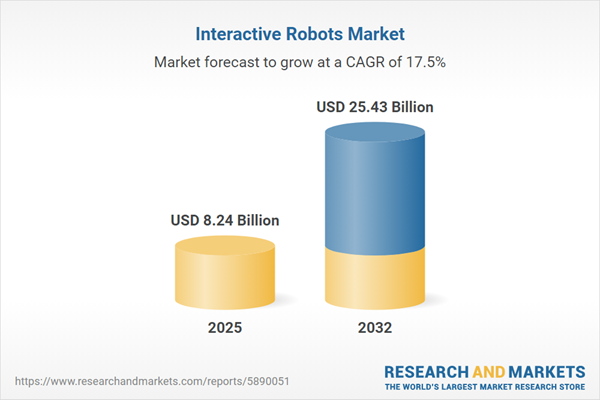Speak directly to the analyst to clarify any post sales queries you may have.
Interactive robotics is transforming operational efficiency and decision-making across industries, making it a pivotal factor in the next phase of digital and workforce transformation. Executive teams are prioritizing strategic adoption of interactive robots to elevate capabilities, drive cost efficiency, and address rapidly evolving sector demands.
Market Snapshot: Interactive Robots Market 2024–2032
The Interactive Robots Market grew from USD 7.01 billion in 2024 to USD 8.24 billion in 2025, and it is expected to expand at a CAGR of 17.46%, reaching USD 25.43 billion by 2032. This dynamic market integrates advanced sensing, adaptive controls, and human-machine interfaces, fostering increased adoption across manufacturing, healthcare, logistics, and service-oriented sectors globally.
Scope & Segmentation of the Interactive Robots Market
This market research thoroughly analyzes the breadth of interactive robotics by application, robotics modality, regional reach, and corporate developments.
- Application Areas: Defense and Public Safety; Education and Research; Entertainment; Healthcare; Manufacturing and Logistics; Retail and Hospitality
- Notable Tasks Within Applications: Bomb disposal; Search and rescue; Surveillance; Research and development; Teaching; Film and media; Gaming and theme parks; Cleaning and sanitization; Rehabilitation and therapy; Surgical assistance; Assembly and welding; Material handling; Warehouse automation; Cleaning and service; Customer engagement; Inventory management
- Autonomous Modalities: Aerial robots; Legged robots; Underwater robots; Wheeled robots
- Regional Coverage: Americas (including North America and Latin America), Europe, Middle East & Africa, Asia-Pacific
- Countries Featured: United States; Canada; Mexico; Brazil; Argentina; Chile; Colombia; Peru; United Kingdom; Germany; France; Russia; Italy; Spain; Netherlands; Sweden; Poland; Switzerland; United Arab Emirates; Saudi Arabia; Qatar; Turkey; Israel; South Africa; Nigeria; Egypt; Kenya; China; India; Japan; Australia; South Korea; Indonesia; Thailand; Malaysia; Singapore; Taiwan
- Leading Companies Analyzed: Universal Robots A/S; ABB Ltd; FANUC Corporation; KUKA Aktiengesellschaft; Techman Robot Inc.; Yaskawa Electric Corporation; OMRON Corporation; Doosan Robotics Co., Ltd; Mitsubishi Electric Corporation; Seiko Epson Corporation
Key Takeaways for Senior Decision-Makers
- Interactive robotics is reshaping operational models, enabling collaborative workspaces that enhance safety and productivity while opening new possibilities for cross-industry applications.
- Advancements in artificial intelligence, sensor technologies, and edge computing are making these robots more adept at interpreting human intent and adapting to dynamic environments.
- Strategic partnerships between robotics firms and software innovators are accelerating the integration of advanced perception systems and customizable interfaces to meet sector-specific demands.
- Adoption is strongest in sectors with high requirements for precision or reliability, such as healthcare, e-commerce logistics, and defense, where transformative benefits include lower cycle times and improved employee satisfaction.
- Service industries are increasingly leveraging interactive robots to provide differentiated customer experiences and improve operational resiliency.
- Ecosystem collaboration through alliances and open-source platforms is lowering entry barriers and supporting faster deployment and innovation cycles for enterprises.
Tariff Impact: Navigating Supply Chain Realignment and Global Competitiveness
Recent United States tariff actions on robotics components have led manufacturers to evaluate localization, nearshoring, and supplier diversification strategies. While some companies have redistributed value chains domestically or regionally, these shifts have affected workforce training and quality assurance requirements. International competitors are using favorable trade conditions to pursue US market expansion, fostering strategic alliances and new competition dynamics.
Methodology & Data Sources
The report utilizes a blend of primary and secondary research, combining structured interviews with executives, end-user surveys, and expert panel discussions with extensive reviews of scientific publications, industry journals, and regulatory filings. Data triangulation, scenario analysis, and peer reviews ensure reliability, statistical rigor, and actionable insights for decision-makers.
Why This Report Matters
- Informs executives on competitive positioning and new market opportunities by delivering a comprehensive overview of the interactive robotics landscape and adoption drivers.
- Equips strategy teams with actionable recommendations to respond to emerging risks, supply chain developments, and sector-specific technology trends.
- Supports investment, procurement, and innovation planning with granular segmentation and credible, up-to-date analysis of key industry players and regional dynamics.
Conclusion: Strategic Significance of Interactive Robotics
Interactive robotics is set to shape the future of enterprise operations and digital transformation. Organizations adopting these solutions can anticipate greater agility, sustainable growth, and an enhanced ability to meet evolving market expectations.
Additional Product Information:
- Purchase of this report includes 1 year online access with quarterly updates.
- This report can be updated on request. Please contact our Customer Experience team using the Ask a Question widget on our website.
Table of Contents
3. Executive Summary
4. Market Overview
7. Cumulative Impact of Artificial Intelligence 2025
Companies Mentioned
The companies profiled in this Interactive Robots market report include:- Universal Robots A/S
- ABB Ltd
- FANUC Corporation
- KUKA Aktiengesellschaft
- Techman Robot Inc.
- Yaskawa Electric Corporation
- OMRON Corporation
- Doosan Robotics Co., Ltd
- Mitsubishi Electric Corporation
- Seiko Epson Corporation
Table Information
| Report Attribute | Details |
|---|---|
| No. of Pages | 193 |
| Published | October 2025 |
| Forecast Period | 2025 - 2032 |
| Estimated Market Value ( USD | $ 8.24 Billion |
| Forecasted Market Value ( USD | $ 25.43 Billion |
| Compound Annual Growth Rate | 17.4% |
| Regions Covered | Global |
| No. of Companies Mentioned | 11 |









